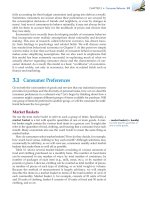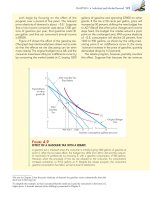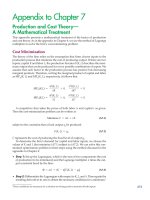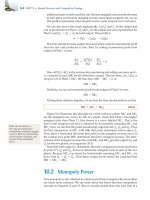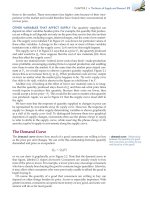(8th edition) (the pearson series in economics) robert pindyck, daniel rubinfeld microecon 131
Bạn đang xem bản rút gọn của tài liệu. Xem và tải ngay bản đầy đủ của tài liệu tại đây (97.4 KB, 1 trang )
106 PART 2 • Producers, Consumers, and Competitive Markets
4. Indifference curves, which represent all combinations
of goods and services that give the same level of satisfaction, are downward-sloping and cannot intersect
one another.
5. Consumer preferences can be completely described by
a set of indifference curves known as an indifference
map. An indifference map provides an ordinal ranking
of all choices that the consumer might make.
6. The marginal rate of substitution (MRS) of F for C is
the maximum amount of C that a person is willing
to give up to obtain 1 additional unit of F. The MRS
diminishes as we move down along an indifference
curve. When there is a diminishing MRS, indifference
curves are convex.
7. Budget lines represent all combinations of goods for
which consumers expend all their income. Budget
lines shift outward in response to an increase in consumer income. When the price of one good (on the
horizontal axis) changes while income and the price of
the other good do not, budget lines pivot and rotate
about a fixed point (on the vertical axis).
8. Consumers maximize satisfaction subject to budget
constraints. When a consumer maximizes satisfaction
by consuming some of each of two goods, the marginal
rate of substitution is equal to the ratio of the prices of
the two goods being purchased.
9. Maximization is sometimes achieved at a corner solution in which one good is not consumed. In such cases,
the marginal rate of substitution need not equal the
ratio of the prices.
10. The theory of revealed preference shows how the
choices that individuals make when prices and income
vary can be used to determine their preferences. When
an individual chooses basket A even though he or she
could afford B, we know that A is preferred to B.
11. The theory of the consumer can be presented by
two different approaches. The indifference curve
12.
13.
14.
15.
approach uses the ordinal properties of utility (that
is, it allows for the ranking of alternatives). The utility function approach obtains a utility function by
attaching a number to each market basket; if basket
A is preferred to basket B, A generates more utility
than B.
When risky choices are analyzed or when comparisons
must be made among individuals, the cardinal properties of the utility function can be important. Usually
the utility function will show diminishing marginal
utility: As more and more of a good is consumed, the
consumer obtains smaller and smaller increments of
utility.
When the utility function approach is used and both
goods are consumed, utility maximization occurs
when the ratio of the marginal utilities of the two
goods (which is the marginal rate of substitution) is
equal to the ratio of the prices.
In times of war and other crises, governments sometimes ration food, gasoline, and other products, rather
than allow prices to increase to competitive levels.
Some consider nonprice rationing to be more equitable
than relying on uncontested market forces.
An ideal cost-of-living index measures the cost of buying, at current prices, a bundle of goods that generates
the same level of utility as was provided by the bundle
of goods consumed at base-year prices. The Laspeyres
price index, however, represents the cost of buying
the bundle of goods chosen in the base year at current
prices relative to the cost of buying the same bundle at
base-year prices. The CPI, even with chain weighting,
overstates the ideal cost-of-living index. By contrast,
the Paasche index measures the cost at current-year
prices of buying a bundle of goods chosen in the current year divided by the cost of buying the same bundle at base-year prices. It thus understates the ideal
cost-of-living index.
QUESTIONS FOR REVIEW
1. What are the four basic assumptions about individual
preferences? Explain the significance or meaning of
each.
2. Can a set of indifference curves be upward sloping? If
so, what would this tell you about the two goods?
3. Explain why two indifference curves cannot intersect.
4. Jon is always willing to trade one can of Coke for
one can of Sprite, or one can of Sprite for one can of
Coke.
a. What can you say about Jon’s marginal rate of substitution?
b. Draw a set of indifference curves for Jon.
c. Draw two budget lines with different slopes and
illustrate the satisfaction-maximizing choice. What
conclusion can you draw?
5. What happens to the marginal rate of substitution as
you move along a convex indifference curve? A linear
indifference curve?
6. Explain why an MRS between two goods must equal
the ratio of the price of the goods for the consumer to
achieve maximum satisfaction.
7. Describe the indifference curves associated with two
goods that are perfect substitutes. What if they are perfect complements?
8. What is the difference between ordinal utility and
cardinal utility? Explain why the assumption of cardinal utility is not needed in order to rank consumer
choices.
9. Upon merging with the West German economy,
East German consumers indicated a preference for

